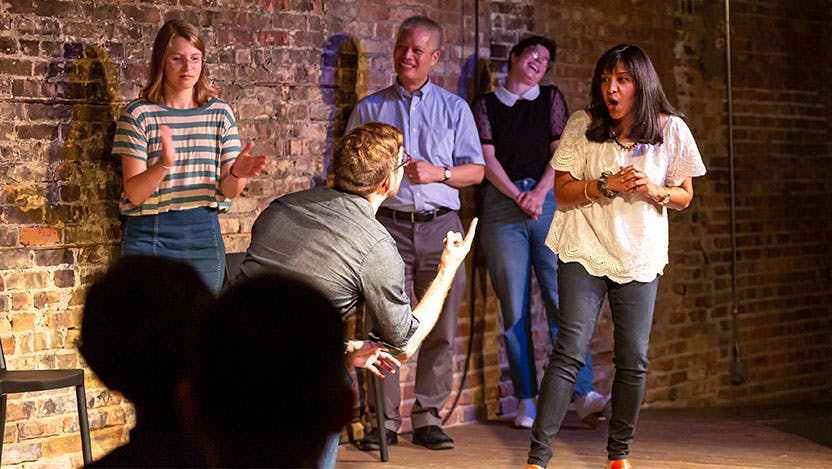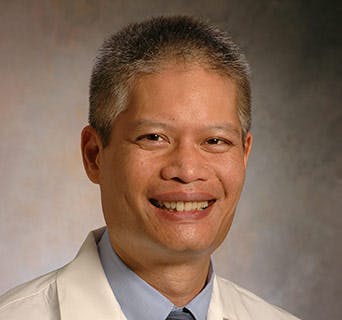How do you teach advancing health equity? Improv may be a (serious) answer

Vineet Arora, MD, Dean for Medical Education for the University of Chicago Pritzker School of Medicine, performs with the improv troupe The Excited State at the Revival Theater in Hyde Park. Internist Marshall Chin, MD, MPH, center, and members of the troupe look on.
Improv and other art forms are good at addressing many of the challenges that we talk to students about at the beginning of the term, like bridging differences in perspectives, creating a safe space and dealing with the grayness and uncertainty of medicine.”
While some medical schools have incorporated improv and other nontraditional methods to teach general listening and people skills, few, if any, have used them specifically to address health equity and issues like power, class and racism, Chin said.
Inspired, Chin gathered a 13-person team of physicians and scientists with skills in medical training, health equity, the arts and/or science communications, as well as entertainers and a program administrator to design and implement workshops. The group represented a diverse set of perspectives, experiences and cultural backgrounds.
The team developed four 90-minute virtual programs that used multiple forms of performance and art to encourage students to explore ways to advance health equity. The team launched a pilot program in 2020 as part of the Pritzker School of Medicine’s health equity requirement for first-year students. Learnings from the course were published as part of an Watch a video abstract
Sharing Experiences, Broadening Perspectives
During the workshops, students were broken into groups that used one of the following arts to explore inequities: improvisational or standup comedy; graphic medicine (comics and comic strips); and the Theatre of the Oppressed, a method that uses theater to promote social change.
Students using graphic medicine, for instance, were asked to draw a picture of themselves as a physician and to imagine what others thought and said about them. Students were invited to share and discuss their drawings to explore perceptions.
Teaching about equity through pure lecturing does not have the same impact that sharing and discussing a lived experience does.
Meanwhile, improv participants were required to watch and mimic the sounds and movements of others onscreen and then discuss the experience. The lesson is meant to reinforce the idea that “listening” includes paying close attention to body language and other nonverbal clues.
What makes these activities effective, Chin says, is the personal storytelling and discussions.
“Teaching about equity through pure lecturing does not have the same impact that sharing and discussing a lived experience does,” he said, referencing a key insight by team member/additional author Brian C. Callender, MDDoriane C. Miller, MD,Monica E. Peek, MD, MPH, and Jennifer M. Rusiecki, MD, of the University of Chicago; and Marshall Chin, MD, MPH, is a general internist with extensive experience improving the care of vulnerable patients with chronic disease. The Pritzker School of Medicine is one of few medical schools to be located physically on its University campus, offering both intellectual and social advantages to students.
Marshall Chin, MD
Pritzker School of Medicine
